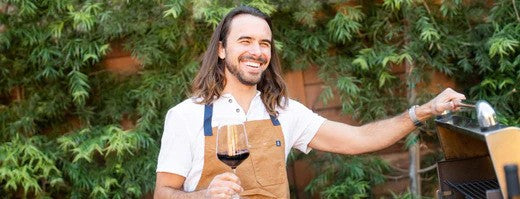
How Many Calories in a Glass of Red Wine?
Maybe you’ve started a new diet or you’re simply curious how many calories could be hiding in your red wine glass.
Thankfully, there are a few easy indicators to look for when determining if the red wine you’re craving is higher or lower in calories so that you don’t have to give up your favorite after-work treat.
Keep reading to learn how many calories are in a glass of red wine, along with the variety of low and high-calorie options.

Red Wine Serving Sizes
The standard serving size for a glass of wine is 5 oz per glass. Depending on the type of wine, a glass of red wine averages 125 calories but can range from 100 calories to 165 calories or more.
The standard size of a bottle of wine is 750ml, which contains 5 glasses.
The average calories in a bottle of red wine can range anywhere from 600 calories to 900 calories per bottle.
Classic red wines like Pinot Noir, Cabernet Sauvignon, Merlot, Gamay, and Grenache are all on the lower calorie side, with around 115 calories to 123 calories per glass.
Conversely, dessert red wines like fortified Port can have up to 200 or more calories per 5 oz glass.
That’s quite a difference!
Of course, there’s much more to be on the lookout for, as calories and serving size alone don’t tell the entire story.

Alcohol Content vs. Sugars
If you want to cut down on your red wine calories, you’ll want to pay attention to the alcohol content and added sugars.
Keep in mind that “sugar” and “carbs” can be used interchangeably; the more sugar in your red wine, the more carbs.
But alcohol is the by far the biggest culprit when it comes to calories as it contains almost double the calories per gram as sugar.
To break it down, 1 gram of sugar is 4 calories, while 1 gram of alcohol is 7 calories.
The more alcohol, the higher the chances that your wine could push you past your daily calorie limit.
When assessing a bottle of wine, you’ve likely noticed the letters “ABV” near the bottom, preceded by a “%.”
“ABV” stands for “alcohol by volume.” The “%” before tells us how much of the wine is pure alcohol.
To further illuminate this, low-alcohol wine is less than 12.5% ABV per bottle, moderate-alcohol wine is 12.5%-14% ABV, and high-alcohol wines contain anything at or above 14.5% ABV.
As for sugars, you’ll likely be able to see how much added sugar a wine has by its nutritional label on the back. But you might need to go online for this information as not all wines have nutrition labels, especially if they are more prestigious or expensive.
If you’d like to know how much residual sugar a red wine has (or the natural sugar acquired during the fermentation process), you should be able to find this information on the winery website.
Now that we’ve discussed sugar in red wine, what about the calories in dry wine?

Dry Red Wine vs. Sweet Red Wine Calories
At first taste, you might assume that a sweeter wine has more calories. While it’s true that this is often the case, alcohol content is just as much a factor as stated earlier.
Red wines like Shiraz (or Syrah), Malbec, Zinfandel, and Port have some of the highest alcohol content compared to other red wines.
But unlike the dessert wine, Port, Malbec, and Shiraz are both dry wines. Still, these two have more calories than a glass of Cabernet Sauvignon or Merlot because of their higher alcohol content.
Malbec and Shiraz have about 130-140 calories per glass.
So, when looking for a health-conscious red wine, look for one with low alcohol content (below 12.5% ABV) and fewer grams of sugar.
Now that we’ve addressed the caloric differences between sweet and dry red wines, we’ve got one more category to address, and we’re sure that the news will have you feeling bubbly!

What About Sparkling Red Wine?
If you love bubbles in your red wine, you’re in luck as sparkling reds tend to have the lowest amount of calories of other red wines.
Rosé tends to be extremely light in calories as well and both of these types only have about 90-100 calories per glass.
Red Moscatos are not only refreshing but delightfully low in alcohol at only 5-7% ABV.
Some Rosé wines have an alcohol content as low as 11% as well.
Just be careful that your next Red Moscato doesn’t have an exuberant amount of added sugars as some of these can be on the sweeter side.
Sip Your Red Guilt Free!
By their nature, red wines tend to contain more calories than other types like white wines.
But there are ways to mitigate these extra calories, like choosing a red wine with lower alcohol per volume and fewer added sugars.
If your favorite red still doesn’t meet these requirements, try lessening the serving size. Instead of two glasses, maybe one will suffice.
Another thing to keep in mind is to make sure you have something in your stomach before sipping your red wine.
These are just a few hacks to help you enjoy that glass of red wine you’ve been craving guilt-free.